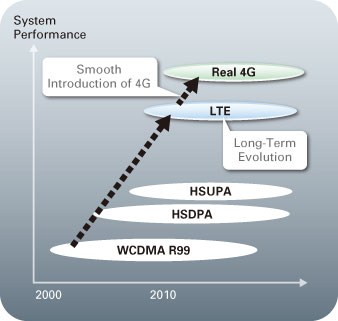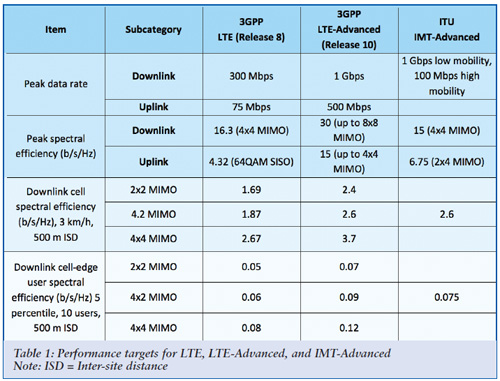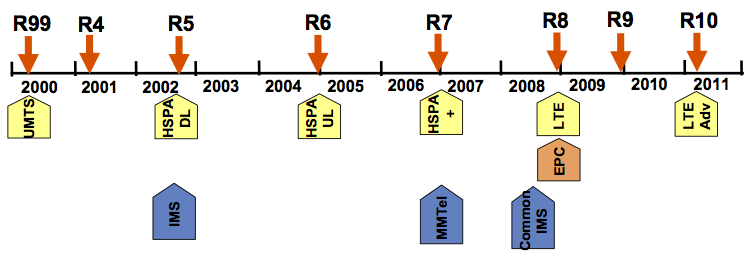The Long-Term Evolution (LTE) is often called “4G”, but many also claim that LTE release 10, also known to as LTE-Advanced, is the true 4G evolution step, with the first release of LTE ( Release 8 ) then being labeled as “3.9G”.
This ongoing race of increasing sequence numbers of mobile system generations is in fact just a matter of labels. What is essential is the actual system capabilities and how they have advanced.
The evolution of 3G systems into 4G is powered by the creation and growth of new services for mobile devices, and is enabled by advancement of the technology available for mobile systems. There has also been an evolution of the environment in which mobile systems are deployed and operated, in terms of levels of competition between mobile operators, challenges from other mobile technologies, and new regulation of spectrum use and market aspects of mobile systems.

Fixed telephony (POTS) and earlier generations of mobile technology were developed for circuit switched services, primarily voice. The first data services over GSM were circuit switched, with packet-based GPRS following in as a later addition. This also affected the first development of 3G,which was primarily based on circuit switched data, with packet-switched services as an add-on. It was not until the 3G evolution into HSPA and later LTE/LTE-Advanced that packet-switched services and IP were made the primary design target. The old circuit-switched services remain, but will on LTE be provided over IP, with Voice-over IP (VoIP) as an example.
IP is in itself service agnostic and thereby enables a range of services with different requirements.The main service-related design parameters for a radio interface supporting a variety of services are:
Data rate: Many services with lower data rates such as voice services are important and still occupy a large part of a mobile network’s overall capacity, but it is the higher data rate services that drive the design of the radio interface. The ever increasing demand for higher data rates for web browsing, streaming and file transfer forces the peak data rates for mobile systems from kbit/s for 2G, to Mbit/s for 3G and getting close to Gbit/s for 4G.
Delay: Interactive services such as real-time gaming, but also web browsing and interactive file transfer, have requirements for very low delay, making it a primary design target. There are, however, many applications such as e-mail and television where the delay requirements are not as strict. The delay for a packet sent from a server to a client and back is called latency.
Capacity: From the mobile system operator’s point of view, it is not only the peak data rates provided to the end-user that are of importance, but also the total data rate that can be provided on average from each deployed base station site and per hertz of licensed spectrum. This measure of capacity is called spectral efficiency. In the case of capacity shortage in a mobile system, the Quality-of-Service (QoS) for the individual end-users may be degraded.

What is the motivation behind LTE?
LTE must be able to deliver performance superior to that of existing 3GPP networks based on HSPA technology. The performance targets in 3GPP are defined comparable to HSPA in Release 6. The peak user throughput should be a minimum of 100 Mbps in the downlink and 50 Mbps in the uplink, which is ten times more than HSPA Release 6.
The main performance targets are:
- spectral efficiency two to four times more than with HSPA Release 6;
- peak rates surpass 100 Mbps in the downlink and 50 Mbps in the uplink;
- allows a round trip time of
- packet switched enhanced;
- high level of mobility and security;
- enhanced terminal power efficiency;
- frequency versatility with allocations from below 1.5MHz up to 20 MHz.

What is LTE Advanced?
International Mobile Telecommunications – Advanced (IMT-Advanced) is a concept for mobile systems with capabilities beyond IMT-2000. IMT-Advanced was formerly known as ‘Systems beyond IMT-2000’. The candidate recommendations for IMT-Advanced were submitted to ITU in 2009. Only two candidates were submitted: LTE-Advanced from 3GPP and IEEE 802.16m.
It is envisaged that the new features of these IMT-Advanced systems will allow a wide range of data rates in multi-user environments with target peak data rates of up to approximately 100 Mbps for high mobility requirements and up to 1 Gbps for low mobility requirements such as nomadic/local wireless access. IMT-Advanced function within 3GPP is called LTE-Advanced (LTE-A) and it is part of Release 10. 3GPP submitted an LTEAdvanced proposal to ITU in October 2009 and more detailed work was done during 2010.
The content material was frozen in December 2010 and the backwards compatibility in June 2011.
The main technology elements in Release 10 LTE-Advanced include:
- carrier aggregation up to 40MHz total band, and later on potentially up to 100 MHz;
- MIMO evolution up to 8 × 8 in downlink and 4 × 4 in uplink;
- relay nodes for offering simple transmission solution;
- heterogeneous networks for optimized interworking between cell layers including macro, micro, pico and femto cells.
LTE-Advanced features are designed in a backwards-compatible way where LTE Release 8 devices can be used on the same carrier where new LTE-Advanced Release 10 features are activated.

Permalink
Permalink
Good information on technology updates.Nice way to explain roadmap of technology.
I like motivations of LTE.Good points.
You can also get some 15 Bullet points on LTE introduction from here